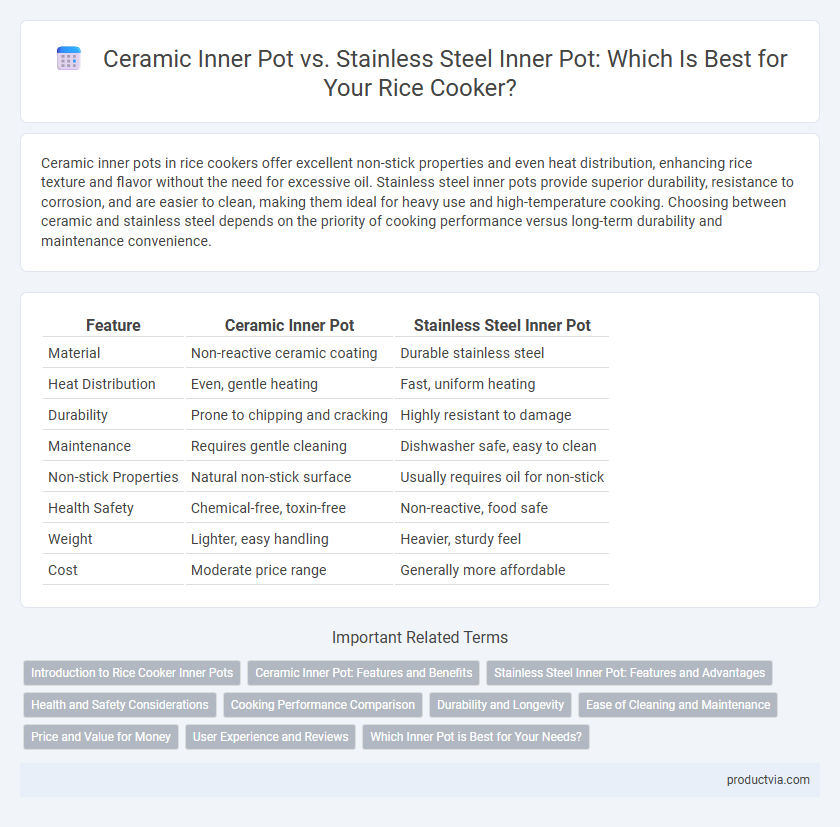Ceramic inner pots in rice cookers offer excellent non-stick properties and even heat distribution, enhancing rice texture and flavor without the need for excessive oil. Stainless steel inner pots provide superior durability, resistance to corrosion, and are easier to clean, making them ideal for heavy use and high-temperature cooking. Choosing between ceramic and stainless steel depends on the priority of cooking performance versus long-term durability and maintenance convenience.
Table of Comparison
| Feature | Ceramic Inner Pot | Stainless Steel Inner Pot |
|---|---|---|
| Material | Non-reactive ceramic coating | Durable stainless steel |
| Heat Distribution | Even, gentle heating | Fast, uniform heating |
| Durability | Prone to chipping and cracking | Highly resistant to damage |
| Maintenance | Requires gentle cleaning | Dishwasher safe, easy to clean |
| Non-stick Properties | Natural non-stick surface | Usually requires oil for non-stick |
| Health Safety | Chemical-free, toxin-free | Non-reactive, food safe |
| Weight | Lighter, easy handling | Heavier, sturdy feel |
| Cost | Moderate price range | Generally more affordable |
Introduction to Rice Cooker Inner Pots
Rice cooker inner pots typically come in ceramic or stainless steel materials, each offering distinct advantages for cooking efficiency and maintenance. Ceramic inner pots provide excellent heat retention and non-stick properties, ensuring even cooking and easy cleaning. Stainless steel inner pots are durable, resistant to corrosion, and maintain consistent heat distribution, making them ideal for long-term use and high-temperature cooking.
Ceramic Inner Pot: Features and Benefits
Ceramic inner pots in rice cookers offer superior non-stick properties and even heat distribution, preventing rice from burning or sticking while ensuring consistent cooking results. These pots are naturally chemical-free, providing a safer cooking environment by avoiding potential toxins found in some coatings. Additionally, ceramic material retains heat efficiently, helping maintain the temperature of cooked rice for longer periods without overcooking or drying out.
Stainless Steel Inner Pot: Features and Advantages
Stainless steel inner pots in rice cookers offer exceptional durability and resistance to corrosion, ensuring long-lasting performance. Their non-reactive surface prevents flavor alteration, making them ideal for cooking a variety of rice types without absorbing odors or stains. These pots also provide excellent heat distribution, contributing to evenly cooked rice and easier cleaning compared to non-stick or ceramic alternatives.
Health and Safety Considerations
Ceramic inner pots in rice cookers offer non-toxic, BPA-free surfaces that prevent chemical leaching and reduce health risks, making them ideal for users prioritizing food safety. Stainless steel inner pots provide durability and resistance to rust and corrosion but may release trace metals under high heat, raising minor safety concerns. Choosing between ceramic and stainless steel depends on preferences for non-reactive cooking surfaces versus long-lasting, easy-to-clean materials that ensure optimal health and safety.
Cooking Performance Comparison
Ceramic inner pots provide superior heat retention and even heat distribution, resulting in consistently cooked rice with improved texture and flavor. Stainless steel inner pots excel in durability and fast heating but may create hot spots that can cause uneven cooking or sticking. Overall, ceramic pots enhance cooking performance by ensuring uniform heat, while stainless steel offers robustness but may compromise rice quality.
Durability and Longevity
Ceramic inner pots in rice cookers offer excellent non-stick properties but are more prone to chipping and cracking, affecting their durability over time. Stainless steel inner pots provide superior strength and resistance to corrosion, contributing to longer lifespan and consistent performance. Users seeking long-term durability and minimal maintenance often prefer stainless steel inner pots for rice cookers.
Ease of Cleaning and Maintenance
Ceramic inner pots in rice cookers offer non-stick properties that make cleaning easier, as rice residue rarely adheres to the surface. Stainless steel inner pots require more effort to scrub off stubborn rice grains and may need specialized cleaning products to maintain shine and prevent discoloration. Routine maintenance of ceramic pots involves gentle wiping to avoid scratches, while stainless steel pots demand regular polishing to uphold durability and hygiene.
Price and Value for Money
Ceramic inner pots in rice cookers generally cost more upfront but offer superior non-stick properties and even heat distribution, enhancing cooking quality and durability. Stainless steel inner pots are typically more affordable and provide excellent durability and easy cleaning, making them a cost-effective choice for budget-conscious consumers. Evaluating value for money depends on balancing initial price against long-term benefits like maintenance, lifespan, and cooking performance.
User Experience and Reviews
Ceramic inner pots in rice cookers are praised for their non-stick properties and even heat distribution, enhancing cooking consistency and ease of cleaning according to numerous user reviews. Stainless steel inner pots are favored for durability and resistance to scratches, although some users report uneven cooking or sticking issues compared to ceramic. Overall, ceramic pots receive higher satisfaction scores for softer rice texture and maintenance convenience, while stainless steel appeals to those prioritizing long-term robustness.
Which Inner Pot is Best for Your Needs?
Ceramic inner pots offer excellent non-stick properties and even heat distribution, making them ideal for delicate rice varieties and easy cleaning. Stainless steel inner pots provide superior durability, resistance to corrosion, and faster heating, suitable for frequent use and high-temperature cooking. Choosing the best inner pot depends on your cooking style, with ceramic favored for gentle cooking and stainless steel preferred for robust performance and longevity.
Ceramic Inner Pot vs Stainless Steel Inner Pot for rice cookers Infographic

 productvia.com
productvia.com